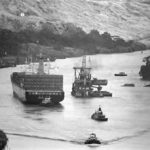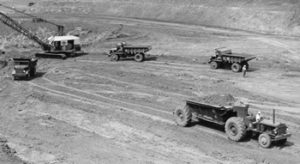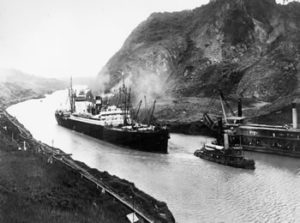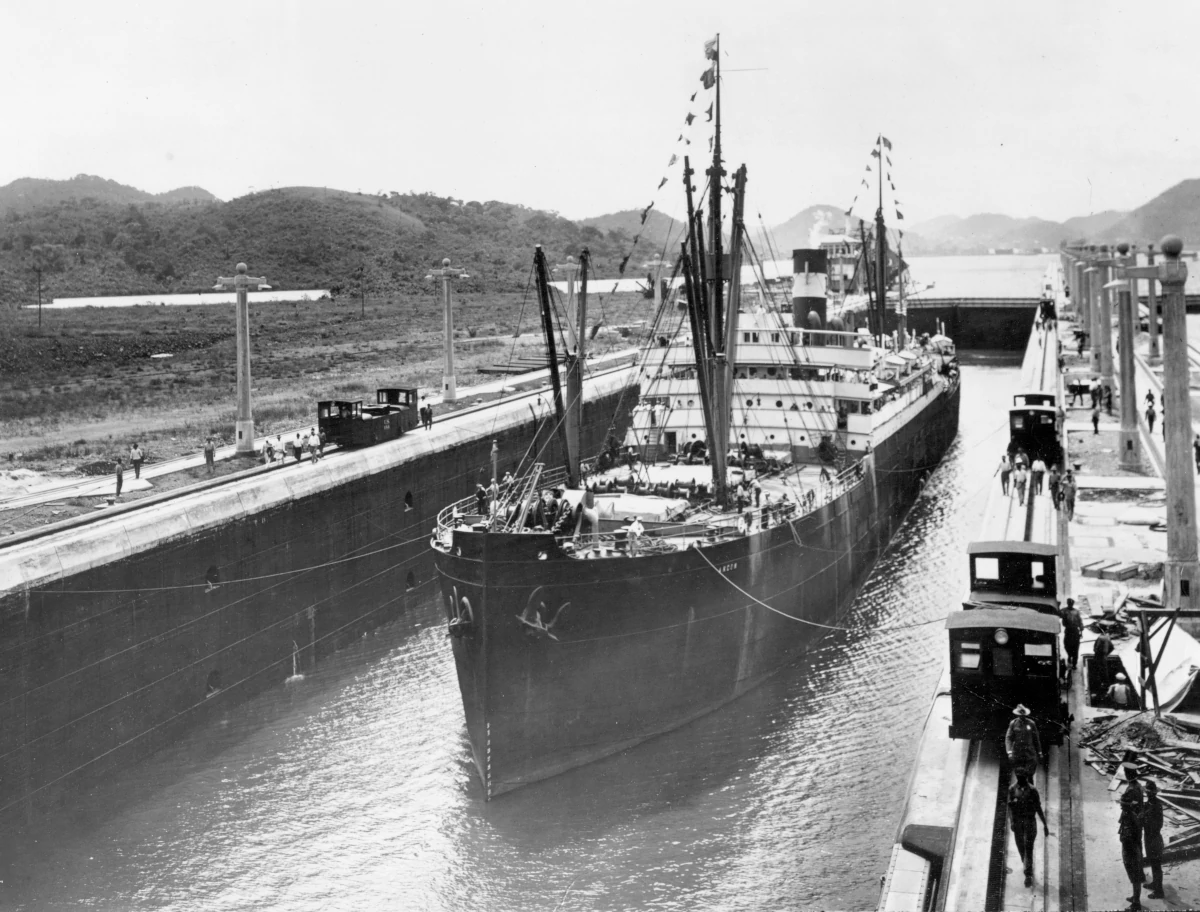Culebra Cut

Culebra Cut was the “special wonder” of the canal. Here, men and machines labored to conquer the 8.75-mile stretch extending through the Continental Divide from Gamboa on the Chagres River at the north to Pedro Miguel on the south. The lowest point in the saddle between Gold Hill on the east and Contractors Hill on the west was at elevation 333.5 feet above sea level.
Holes were drilled, filled with explosives and detonated to loosen the rock and rock-hard clay. Steam shovels then excavated the spoil, placing it on railroad cars to be hauled to dump sites. Excavation equipment, in addition to the railroad itself, included steam shovels, unloaders, spreaders and track-shifters. Of this equipment, only the steam shovel had been known to the French, and then in a much less powerful form. The Lidgerwood unloader, manufactured by the Lidgerwood Manufacturing Company of New York City, was another indispensable piece of equipment. Wooden flatcars with a rated canal capacity of 19 cubic yards hauled most of the spoil, pulled in long trains by full-sized, American built locomotives. Built with only one side, they had steel aprons bridging the spaces between cars. Dirt was piled high against one side. At the dump site, the unloader, a three-ton plow, was hitched to the last car by a long cable to a huge winch-like device mounted on a flatcar at the head of the train. Taking its power from the locomotive, the winch pulled the plow rapidly forward, unloading the whole twenty-car train in a single, 10-minute sweep. One of these machines once set an 8-hour record by unloading 18 trains, about 3 ½ miles of cars containing about 7,560 cubic yards of material. Engineers estimated that 20 of these unloaders operated by 120 laborers did the work of 5,666 men unloading by hand.
The dirt-spreader was another American innovation. A car operated by compressed air, it had steel “wings” on each side that could be raised and lowered. When lowered, they sloped 11.5 feet backward from the rails. Moving forward, the dirt-spreader spread and leveled the material left along the track by the unloader. Like the unloader, the spreader did the work of some 5,000 to 6,000 men working by hand
Another machine, the track-shifter, was invented by American William G. Bierd, general manager of the Panama Railroad from September 1905 to October 1907. The huge crane-like machine would hoist a whole section of track – rails and ties – and swing it in either direction, to relocate it as much as 9 feet at a time. With the tracks at the dumps needing constant shifting to keep pace with the arriving loads of spoil, the track-shifter was extremely useful. It took less than a dozen men operating on the shifter one day to move a mile of track, a task requiring not less than 600 men.
Volquetes

A large number of 17-cubic-yard capacity, 4-sided Western and Oliver dump cars (27 cars comprising a train) was also used. As it was hard to unload the dirt from these cars because the heavy clay would stick to the steel sides, they were used almost exclusively for hauling rock from the Cut to Gatun Dam. Their 4-sided design made them impossible for use with the unloader. More than a hundred million cubic yards of spoil had to be hauled away from the excavation site and dumped. Part of this spoil was used to join a series of four small islands in Panama Bay (Naos, Perico, Culebra and Flamenco) to create a breakwater. This breakwater is topped by a roadway, making it a causeway that extends three and a quarter miles out into the Pacific. The stretch between the mainland and Naos Island was a very troublesome dumping area because of a soft bottom into which tons of rock would settle and virtually disappear. Track and trestle used to haul the spoil to the dumping area would disappear overnight into the ocean and have to be replaced. In the end, to reach Naos Island took ten times the estimated spoil.
Spoil was also used to claim nearly 500 acres of Pacific Ocean to create the Balboa townsite and the Fort Amador military reservation. Millions of cubic yards of material also had to be hauled out to big waste dumps in the jungle. In the largest of these, Tabernilla, 17,000,000 cubic yards of material were deposited. Balboa was the biggest dumpsite. Other big dumps were Gatun Dam, and Miraflores..
Gatun Dam, on the Atlantic, was, at the time of its construction, the largest earthen dam in the world and Gatun Lake the largest manmade body of water in the world. Today, Gatun Lake doesn’t even make the top thirty list of such lakes. Two other dams were built on the Pacific side – the Miraflores Spillway and, in the 1930s, Madden Dam farther up the Chagres River. With the building of Gatun Dam, the Chagres River valley between Gamboa and Gatun became Gatun Lake, with the Chagres flowing into it at Gamboa. The building of Gaillard Cut then extended the lake across the Continental Divide to Pedro Miguel Locks.
Earth slides in Culebra Cut were a constant concern for construction engineers. The first under the American effort occurred at Cucaracha on October 4, 1907 when some 500,000 cubic yards of material moved into the Cut following several days of unusually heavy rain. For ten days the slide moved an average of 14 feet every 24 hours. Cucaracha remains today a slide surveillance area.
A “normal” or “gravity” slide like Cucaracha, the largest of its kind at the Canal, occurs where a layer of porous material rests upon a sloping surface of harder material such as rock. Rainwater saturating the overlying porous material forms a slippery zone against the harder material below, causing the entire top layer, which can vary in thickness from 10 and 40 feet, to slide.
Culebra Cut

Geologists classify another type of slide as “structural break” or “deformation” slides. In these, factors such as unstable geological rock formations, slope steepness and height and the effects of blasting combine to form a slide. At the Canal, excavation removed lateral support from the high banks created in the deepest portions of Culebra Cut. Unable to sustain the weight above it, the slopes sheared and settled forcing the underlying layer of poor-quality rock and soft material to be crushed and forced laterally into the prism of the Canal, heaving up the Canal bottom.
The most formidable slides of this character occur during the dry season, and are in no way due to ground saturation by rainfall.
The two most serious structural break slides during the American construction period occurred on the east bank north of Gold Hill and on the west bank in front of Culebra village. The west bank slide covered a 75-acre area requiring the removal of some 10,000,000 cubic yards of material, and a number of village buildings had to be removed or demolished. The 50-acre Gold Hill slide on the east bank required removal of some 7,000,000 cubic yards of material.
Canal engineers were completely unprepared for and confounded by this unexpected slide activity. In 1906, the minority report of the International Board of Consulting Engineers placed total Culebra Cut excavation for a lock canal at 53,800,000 cubic yards; the minority report estimated the amount necessary for a 40-foot-deep sea level canal at 110,000,000 cubic yards. In 1908 the canal commission revised the Cut excavation estimate to about 78,000,000 cubic yards; in 1910 to 84,000,000; in 1911 to 89,000,000; in 1912 to nearly 94,000,000; and in 1913 to about 100,000,000. The increased Cut excavation required was du partially to an increased bottom width from 200 to 300 feet, an increase of about 13,000 cubic yards, but the slides were the main reason.
The one-year record high for construction-era excavation was set in 1908, with more than 37,000,000 cubic yards of spoil taken from the Cut. This was also the year in which Lieutenant Frederick Mears began directing the relocation of the Panama Railroad line to higher ground ahead of inundation of the existing tracks by the filling of Gatun Lake. Building the 40 miles of new track was completed May 25, 1912, at a cost of nearly $9,000,000.





